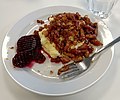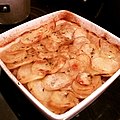| Dish | Image | Culinary origins | Type | Description |
|---|
| Aloo gosht |  | South Asia | stew | Curry consisting of potatoes (aloo) cooked with meat (gosht), usually lamb, mutton or beef, in a shorba gravy [1] [2] |
| Baeckeoffe |  | Alsace | casserole | Braised meat, onions and potatoes [3] [4] |
| Bangers and mash |  | Great Britain | pairing | Traditional pairing of sausages and mashed potato, usually served with onion gravy and often with fried onions and peas [5] [6] [7] |
| Bedfordshire clanger |  | South Midlands | pie | Traditional meat, potato, and onion hand pie made with a suet crust; some versions include a sweet filling at one end [8] [9] |
| Brændende kærlighed |  | Denmark | pairing | Traditional dish consisting of mashed potatoes topped with bacon and fried onions [10] [11] [12] |
| Carne asada fries |  | California | compilation | A Mexican-American dish typically consisting of french fries topped with carne asada, guacamole, sour cream, cheese, and sometimes salsa [13] [14] |
| Carne de porco à alentejana |  | Portugal | stew | Traditional dish consisting of pork and clams served with potatoes [15] |
| Chorrillana |  | Chile | compilation | French fries topped with sliced meat or sausages and often eggs and caramelized onions [16] [17] [18] |
| Coddle |  | Ireland | soup or stew | Sliced pork sausages and rashers cooked with potatoes and onion; traditionally may also include barley [19] [20] [21] [22] |
| Corned beef pie |  | United Kingdom | pie | Corned beef, onion and often sliced or cubed potatoes baked in a pie that may be topped with mashed potatoes, as in Shepherd's pie, or with a traditional pastry crust [23] [24] [25] [26] |
| Halal snack pack |  | Australia | compilation | Halal-certified doner kebab meat (lamb, chicken, or beef) and chips [27] |
| Hash |  | Multiple | sautee | Any of a number of dishes in a variety of cuisines which feature meat, generally left over from a previous meal, and cubed or grated potatoes sauteed together, sometimes with other vegetables [28] |
| Irish stew |  | Ireland | stew | Traditionally lamb or mutton, potatoes, onions, and often carrots in a thick broth [29] |
| Kapsalon |  | Netherlands | compilation | French fries topped with döner, shawarma or gyro meat and Gouda cheese, broiled until the cheese melts, and further topped with shredded iceberg lettuce and sauces [30] |
| Labskaus |  | Northern Europe | thick stew | Salted meat or corned beef, potatoes, and onion [31] [32] |
| Lancashire hotpot |  | North West England | thick stew or casserole | Mutton or lamb and onions topped with sliced potato and covered with broth, slowly baked in a covered pot [33] [34] |
| Lobby | | | stew | |
| Lobscouse |  | Northern Europe | stew | Typically beef or lamb, but sometimes also chicken, pork, or ham and potatoes, often stewed with other vegetables [35] [36] [37] |
| Meat and potato pie |  | England | pie | A pastry casing containing potato, either lamb or beef, and sometimes carrot and/or onion. [38] |
| Mince and tatties |  | Scotland | pairing | Minced beef cooked with onions, carrots or other root vegetables, and stock, sometimes with a thickening agent such as flour, oatmeal or cornflour, served with or over mashed potatoes [39] [40] |
| Nikujaga |  | Japan | braise or stew | Beef or pork, potatoes, and onions stewed in a dashi-based broth, sometimes with ito konnyaku and vegetables, until most of the liquid has been reduced [41] [42] [43] |
| Papa rellena |  | South America | croquette | A potato-based dough which is filled with chopped beef and onions, olives, and hard-boiled eggs, then deep-fried [44] |
| Pichelsteiner |  | Germany | stew | |
| Poutine râpée | | Acadia | dumpling | |
| Pyttipanna |  | Scandinavia | sautee | Chopped or minced meat such as sausage, ham, or meatballs, diced and then pan fried, often served with a fried egg and pickled vegetables [45] [46] |
| Raspeball |  | Norway | dumpling | The main ingredient is peeled potatoes, which are grated or ground up and mixed with flour, usually barley or wheat, to make the balls stick together. Often served for dinner with salted lamb meat and sausage. |
| Revuelto Gramajo |  | Argentina | sautee | Fried julienned potatoes, ham and eggs [47] |
| Rössypottu |  | Finland | stew | Potatoes, pork, and blodpalt, a dumpling made of blood, beer, and rye flour [48] |
| Salchipapa |  | Latin America | compilation | |
| Scouse |  | Liverpool | stew | |
| Shepherd's pie |  | Britain and France | pie or casserole | Meat and vegetables covered with mashed potato and baked [49] [50] |
| Slinger |  | St. Louis, Missouri | compilation | Eggs, hash browns, and a ground beef patty, covered in chili con carne, cheese and onions [51] |
| Sodd |  | Norway | soup | Mutton with beef or lamb meatballs, potatoes and other vegetables in a clear broth [52] [53] [54] [55] |
| Spice bag |  | Ireland | compilation | French fries topped with salt and chilli chicken and vegetables [56] [57] |
| Steak frites |  | Belgium | pairing | Beef steak paired with fried potatoes [58] |
| Stegt flæsk |  | Denmark | pairing | Fried pork belly served with potatoes and parsley sauce [59] [60] |
| Tourtière |  | French Canada | pie | Pork, veal, beef, fish, or game and potatoes [61] |
| Trinxat |  | Catalonia and Andorra | sautee | Potatoes, cabbage and pork [62] |
| Xogoi Momo | | Tibet | dumpling | Potato dough with a minced meat filling [63] |



































